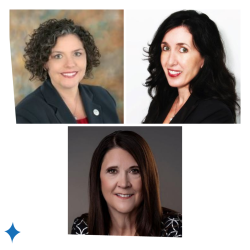The wisdom of generations before ours says that “a rising tide lifts all boats,” to which modern clinical research veterans might add, “building a sense of community among scattered clinical trial sites can help to keep all of the stakeholders in medical research afloat in trying times.”
Addressing a framework for assessing the overall robustness at sites in terms of compliance, business, financial, regulatory, and clinical dimensions is the goal of an ACRP 2025 preconference half-day workshop being offered in New Orleans next April, “Vital Signs: Evaluating the Health of Your Clinical Research Program.” The presenters are Cynthia Dunn, RN, BSN, MSN, CCRA, CCRP, CHRC, CPC, a Clinical Research Consultant with Crescent City Research Consulting LLC; Wendy Portier, MSN, RN, CHRC, CHC, CPC, Managing Director of Portier & Associates, LLC; and Kelly Willenberg, DBA, RN, CCRP, CHC, CHRC, CEO of Kelly Willenberg, LLC.
“This workshop will help attendees to identify gaps, inefficiencies, and areas for improvement in their programs,” says Portier. “Participants will complete a research program scorecard covering essential topics, leading to an overall health score on their individual research programs and follow-up action plans based on metrics.”
Although mainly aimed at the study site side of the enterprise, attendees can benefit even if they are from sponsors or contract research organizations, “by hearing the challenges that sites have from an operational perspective—looking at all of these key areas and what they need to be concerned about in terms of best practices—especially where compliance is concerned,” Portier adds. “I think just meeting people from other organizations that have the same issue or problem or gap means a whole lot in this space.”
Even the research staff at experienced sites may not be aware of certain metrics they should be measuring and reporting on in order to operationalize improvements, the presenters say. Partly to blame is the modern workplace culture generated by so much remote and hybrid activities where once people saw their colleagues more often face-to-face.
“I think there are good and bad aspects to all of the remote possibilities out there,” Dunn points out. Also, “you may have a 15-year-old site with staff who have only ever worked in clinical trials at that site, so they just don’t know anything else but what they do there, or that there may be better ways to do things. I think that if people had support and they realized that they needed those connections, they could gain from them, and see that none of us are alone in this fight. A culture of connectedness is a culture that we need.”
Workshop—Vital Signs: Evaluating the Health of Your Clinical Research Program
Join Cynthia, Wendy, and Kelly at ACRP 2025 [April 24-27; New Orleans, La.], where they will provide a framework to assess the overall “health” of your clinical research program. View complete schedule.
In such a complex environment, and with the departures of more and more long-time research professionals causing high rates of turnover, many newcomers to the field are not necessarily as savvy about key issues as would be ideal, Willenberg adds, especially regarding healthcare innovation being driven by artificial intelligence and other transformations in research practices.
“If they are in a role now where they are just having things dumped on them because there’s people leaving the site or there’s turnover, it can be a very big issue for patient safety,” she says. “We have to learn not to just barrel down the track, letting the pressure to enroll patients and get studies done cloud our judgement, because that’s not safe for anyone.”
Author: Gary Cramer




